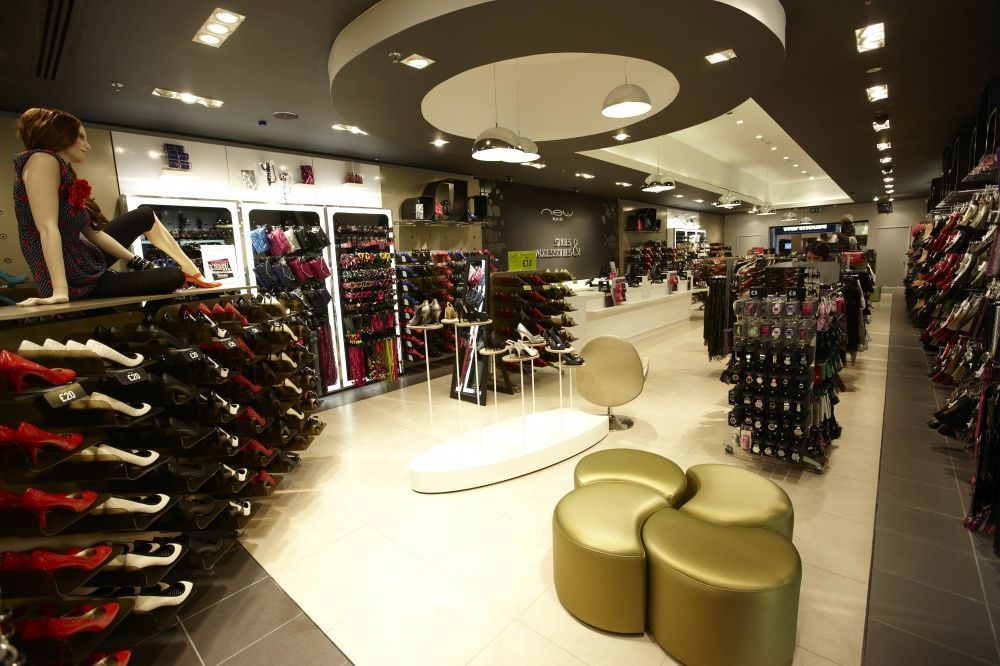
The basic rules of organizing a retail space in a shoe store of the mass market segment

We are publishing an excerpt from Dmitry Galun’s book “Visual Merchandising for One-Two-Three-Four-Five”, the circulation of which was completely sold out in a few months.
 Dmitry Galun - Specialist in visual merchandising of clothing and footwear stores with experience in retail chains such as Steilmann, InCity, ZimaLetto, Sela. The author of the book “Visual merchandising for one-two-three-four-five”, published by the publishing house “Peter” in 2012 and completely sold out in a few months.
Dmitry Galun - Specialist in visual merchandising of clothing and footwear stores with experience in retail chains such as Steilmann, InCity, ZimaLetto, Sela. The author of the book “Visual merchandising for one-two-three-four-five”, published by the publishing house “Peter” in 2012 and completely sold out in a few months.Trade software
You can sell shoes in almost any environment. For example, in Milan, during the tourist season, boxes are put on the streets and create conditions for trying on. In this case, the trading equipment is a stool, horn and rug. At a store sale, trade equipment for the presentation of shoes is divided into wall и insular. Wall-mounted equipment is located around the perimeter of the store, usually along the right, left and central back walls, it is attached to or located near the wall, standing on the floor or hanging from the ceiling. It is for this reason that it is called wall.
Island equipment is located inside the trading floor. In practice, you can also find the name "floor" or "free-standing." Trading equipment can be mobile and stationary. Mobile island equipment provides for the possibility of rearrangements both inside the trading floor and its individual elements (shelves) within the framework of one design. Mobile wall allows you to rearrange the shelves in height. As a rule, these are various kinds of perforated guides with removable elements.
For the presentation of shoes are mainly used shelves and tables. This is dictated by the small volume of the product, its relatively small width and height. The dimensions of the trade equipment for the presentation of shoes are determined, first of all, by the dimensions of the product itself.
Depth of shelves. Presentation of one shoe model of the same color of the same size usually requires at least 35 cm of depth. This depth will allow you to vertically expose men's shoes of the largest size and the toe of the shoe will not go beyond the shelf. Mass market stores are characterized by a very large capacity of goods on the trading floor (up to 30 units per square meter or up to 10 units per linear meter or up to 1200 models per season). For this reason, the task of the architect is to free up as much space as possible for the presentation of the goods (especially in small areas). In this case, the depth of the shelves can be reduced to 25 cm, while the shoes will be placed diagonally, otherwise the toe will go beyond the shelf.
Height between shelves Depends on the assortment of shoes.
So, for the presentation of medium-height boots, 45 cm is necessary. Since boots are more characteristic of the women's assortment, a similar height between adjacent shelves is necessary for sections of the trade equipment on which the women's collections are located. With mobile trading equipment, shelves can be rearranged to increase the height; with stationary equipment, this need to be taken into account in advance when designing, or only the upper shelves should be used for the presentation of tall products. For the presentation of shoes and ankle boots, the height of the shelves in 30 cm is enough.
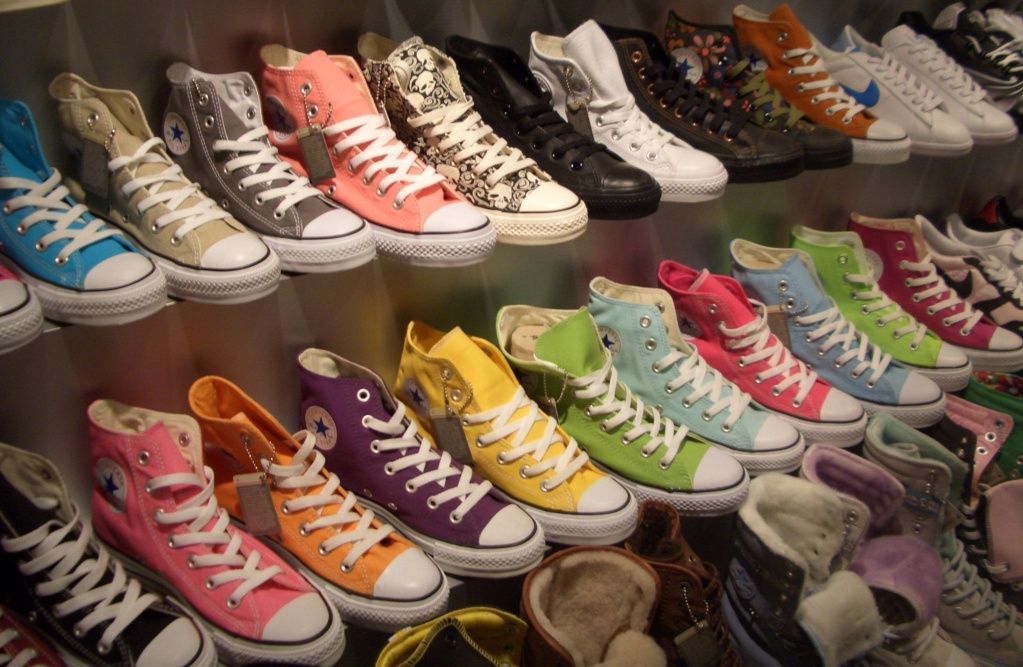 Number of shelves on walls or island structures depends on the quantity of goods, but, as a rule, does not exceed six, while the lower shelf is at floor level, the upper one at the level of human eyes, i.e. approximately 150 cm from the floor. Placing shoes at a higher height is ineffective for sales, since the shoes are visible from below (heel and sole). When making a purchasing decision, the look of the sole and heel is of secondary importance. And although a person can take goods from a shelf at a height of 180 cm, the percentage of purchase of products from these shelves will be minimal, since this is not very convenient.
Number of shelves on walls or island structures depends on the quantity of goods, but, as a rule, does not exceed six, while the lower shelf is at floor level, the upper one at the level of human eyes, i.e. approximately 150 cm from the floor. Placing shoes at a higher height is ineffective for sales, since the shoes are visible from below (heel and sole). When making a purchasing decision, the look of the sole and heel is of secondary importance. And although a person can take goods from a shelf at a height of 180 cm, the percentage of purchase of products from these shelves will be minimal, since this is not very convenient.
The number of shelves, the distance between them can vary due to the use of mobile trading equipment, in most cases representing perforated axes (guides) in which the shelves are mounted.
We should also mention the growing presentation method. shoes on hangers... This method is used both by specialized footwear brands in the mass market category and by fashion brands of the same price segment that offer a comprehensive purchase of clothing and footwear (H&M, Bershka and others). For such a presentation, wall and island equipment can be used. In both cases, you will need perforated hook guides and hangers for presentation. This method of presenting shoes allows you to increase the capacity of the sales area by 30% compared to the presentation in boxes and by 60% compared to the presentation of single samples.
Trading equipment located in the hall forms customer flows. According to statistics, it is believed that a typical customer flow is directed counterclockwise, i.e. 80% of customers entering the store turn right and go around the store around the perimeter counterclockwise. The explanation of this is the law of the right foot - a person with his right foot takes a step longer and therefore gradually turns left. This direction of human movement is also considered comfortable for him, since most people are right-handed. Obstructing this direction is not recommended. Although the direction of the consumer flow can be changed by means of different distribution of the trading equipment across the trading floor, the construction of various kinds of “barriers”, which can be tables, racks with shelves, furniture for fitting shoes.
In the trading floor should be the main walkways, dividing the trading floor into distinct zones, there must be additional passages that serve to move from one island structure to another inside the same zone. Additional passages must be at least 90 cm. This is the minimum distance within which two people of average physique can disperse. This distance also corresponds to the so-called. "Personal space" of a person. The indicated width of the “corridor” is extremely comfortable for a person from the point of view of psychology. The accumulation of people in the store can lead to a reduction in the visitor’s stay in the store; the lack of people can sow doubt that the store is popular. Therefore, a store is attractive from the point of view of the buyer, in which there are always visitors and at the same time the ability to move freely around the trading floor.
Trading equipment in a separate store, a separate corner (corner) in the shop-in-shop department should be built according to the so-called arena principle. This principle is to gradually increase the height of the trading equipment from the entrance to the far wall. The principle of the arena allows you to view all levels of the store from the entrance to it, the entire product offer is visible from a distance, the panorama of the product unfolds as you approach it. In this case, the likelihood of “catching up" the buyer's eyes with goods located in different parts of the store at different visible levels increases. It follows that it is not recommended to put walls or island structures at the entrance to the store that are more than 120 cm in height.
According to Webster’s dictionary, attention is the act of retaining a thought on an object or the ability to do so. The above definition reflects the fundamental element of attention - focusing. Your focus is currently focused on these lines. If you hear a phone ring, attention will switch to a new object. Before convincing the consumer to pay money for the goods, the company should attract his attention. It is for this purpose that the so-called. "focal point"Or" point of attracting attention. " In the case of a cheap shoe store, a presentation table with shoes and related POS materials will most likely be the point of attracting attention.
Principles of global constellation
Any trading floor can be considered for the distribution of customer activity in a particular area. Thus, the concepts of active and passive zones were introduced into practice. Some experts call them hot and cold, respectively. There is a difference in the definition of active and passive zones in the context of what is considered activity - the percentage of purchases in the store zone in question or the visibility of the zone, the accumulation of customers in it. These two signs of activity may coincide, but this does not always happen. In this case, the pattern identified by retail analysts can serve as a clear analogy - buyers are attracted by bright colors, and sales are dark. The situation resembles the choice of partners: men look at bright women, and take modest wives.
When zoning the space, you should place bright, fashionable color themes in places that are active from the point of view of their visibility by customers, but remember that the store’s turnover is most likely to be achieved by sales of basic colors - black, brown, blue.
The field of view of the human eye is approximately 200 degrees, of which the zone equal to 30 degrees is more active in the sense of perception, the remaining two segments of lateral vision are considered passive. First of all, the consumer’s attention will be attracted to goods falling into the central 30 degrees of the angle of view, i.e. the one that a person sees right in front of him.
Active zones also include the right side of the store. Most people on our planet are right-handed due to the more developed left brain. Most of the movements we make with the right hand, moving from left to right is more natural for most people.
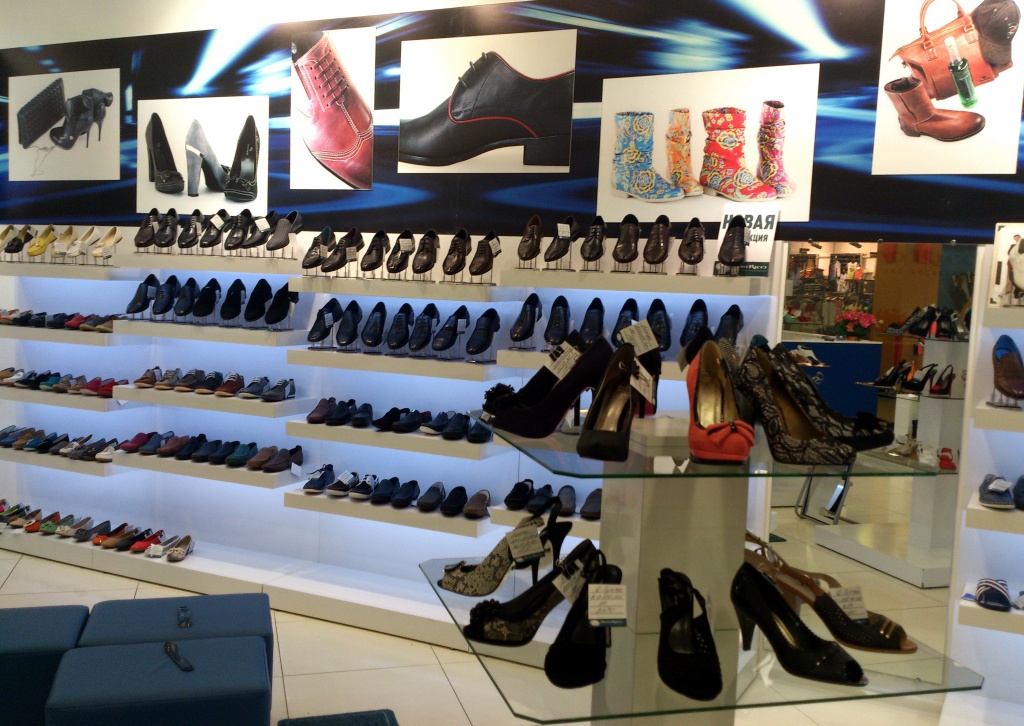 The ticket office belongs to the active zones, there is a large concentration of people paying for purchases. As a rule, queues are formed in these zones, standing in which people are somehow forced to wait and look around. A product that is in the field of view of consumers at this moment will inevitably attract attention. It is in these areas that spontaneous purchases are likely.
The ticket office belongs to the active zones, there is a large concentration of people paying for purchases. As a rule, queues are formed in these zones, standing in which people are somehow forced to wait and look around. A product that is in the field of view of consumers at this moment will inevitably attract attention. It is in these areas that spontaneous purchases are likely.
Passive (or cold) zones are formed because people by their nature do not want to change the direction of movement. These areas include: the left side of the store, dead ends, corners of the sales area. The merchandiser has the opportunity to increase the degree of activity of cold zones by attracting involuntary attention. Irritants such as loud sound, bright light, movement in passive zones attract the attention of the consumer in addition to his will. In addition, the merchandiser can use other methods: change the movement of customer flow by creating a barrier from the trading equipment or by placing a cash register in its path; affect the direction of movement by reducing lighting and widening the passage, placing more attractive goods in the passive zone.
When deciding on which groups and in which areas of the trading floor it is more convenient to locate, one should remember the potential of each zone in relation to the potential of the product group and the time factor. That is, we are talking about regular rotation of the goods. So, the same group of shoes cannot constantly be in the same active or passive zone. During the season, sales of each product group must be stimulated by its placement in the active zone for at least 14 days.
The positions of goods or individual brands must be changed until the main goal is achieved - to obtain economic benefits and increase sales. If, in a comparative analysis of the positions of goods and the effectiveness of individual tables and shelves, significant differences are found, they proceed as follows: goods that are poorly sold are moved to the most advantageous positions.
Principles of local placement
There are two principal ways of arranging shoes in the direction of eye movement of consumers: vertical and horizontal.
Vertical arrangement provides for the arrangement of homogeneous goods in several rows on all shelves of racks from top to bottom. This display of goods is convenient for buyers of any height. With the horizontal arrangement of goods of one group, one product is located next to another. It is believed that the vertical method is more effective than the horizontal, because provides quick orientation in the trading floor. When serving officials and their families, the vertical way is simply a must.
These two methods of placing shoes are due to the theory of structurality, according to which the image is created by several expressive lines, although it may not get much in it. Those. the arrangement of points (pairs of shoes) creates a tendency to group them in different ways so that some are perceived as belonging to one structure, while the rest are rejected or organized into other structures. In our case, the points of the pairs of shoes are grouped into vertical and horizontal lines.
For the presentation of shoes, the use of a shoe spread in front, in profile and half-turn is characteristic. There are brands that adhere to only one of these three areas. But to create a more dynamic presentation of the product, it is most effective to use at least two of them. For ease of maintenance of the presentation of goods by staff, merchandisers often develop a system of alternating profile and front-end presentations.
For the mass market category, the height of the shelf on which the shoes are placed is of fundamental importance. So suppliers of goods to hypermarkets in the figurative sense “fight” for placing goods on shelves placed at the height of human eyes. This is because they account for 40% of human cognitive resources, therefore, they provide the highest sales figures. Shelves at arm's length are also considered active in terms of consumption of products placed on them (30% of cognitive resources). In the mass consumption segment, low shelves and shelves at the floor level are considered ineffective (20%), because with a characteristic large accumulation of goods, attention is concentrated at eye level, and at the floor level there is no incentive that can distract attention and make the consumer bend over. In addition, dust and dirt accumulate at the floor level in stores with high traffic, shoes in this situation may lose their presentation. Often, buyers have a prejudice that these shelves are used for displaying stocks. Thus, the activity of the shelf is reduced from the level of 160 cm down.
In a shoe store of the mass market category, it is possible to use standard compositional principles that determine the integrity of perception. The fact is that with any perception, the image as a whole is most striking, and only then the details emerge; due to the integrity of perception, individual lines and points of the visible are combined into a figure. Take a look at a piece of paper that shows three dots. In accordance with one of the laws of psychology of perception, you will see not only three points, but also a triangle, i.e. figure. Such a figure can be formed using the principles of symmetry, rhythm, contrast, color.
The principal differences from the presentation of luxury shoes are the much more saturated trade equipment with shoes. The consequence of this is the inability to present each model as a complete pair. In addition, there is another argument against exhibiting pairs of shoes - safety. For stores offering consumer goods, there is a large crowd of people and, accordingly, a high probability of theft. For safety reasons, it is customary to display only the right half pair of each model in shoe stores. The pair in this case consists of two right half pairs of different colors of the same model or different models of the same block of the same or different colors. Half-pairs can be placed together in three and four.
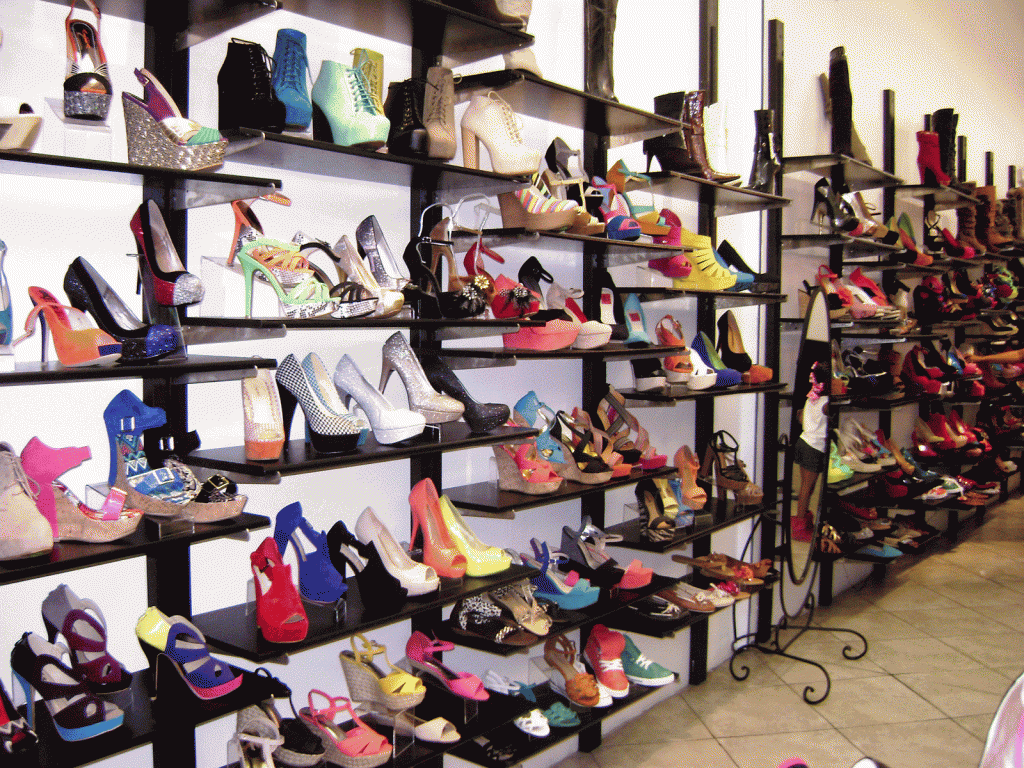 With the local placement of shoes in conditions of widespread consumption, merchandisers appeal more to logic than to aesthetics. For buyers, a logically justified group of shoes locally placed on shelves based on an assortment basis may well be sufficient. That is, on the top shelf are all the boots of the group, on the next - high-heeled shoes, even lower - low-heeled shoes, on the lowest - shoes without heels. Thus, the following relationship can be realized: the higher the heel of the shoe, the higher the shelf on which it is placed.
With the local placement of shoes in conditions of widespread consumption, merchandisers appeal more to logic than to aesthetics. For buyers, a logically justified group of shoes locally placed on shelves based on an assortment basis may well be sufficient. That is, on the top shelf are all the boots of the group, on the next - high-heeled shoes, even lower - low-heeled shoes, on the lowest - shoes without heels. Thus, the following relationship can be realized: the higher the heel of the shoe, the higher the shelf on which it is placed.
In the event that all sizes are not displayed in the store and grouping by size is not implemented, the question arises for the merchandiser: “What size of model should I put in the hall?”. It is recommended to exhibit shoes of the most proportional size (women’s 37, men’s 41) on the trading floor so that a buyer with a larger or smaller foot can directly evaluate the shoe model. There is also the practice of setting the smallest sizes for ease of communication with the buyer regarding the availability of sizes, as in this case, the seller always knows that the smallest size is presented on the trading floor. If the smallest size is difficult to see, put the largest. If the largest does not fit anywhere, decide what to do, yourself. In the case of the presentation of shoes on hangers, the minimum shoe size is placed closest to the buyer, then the sizes are arranged in ascending order.
The appearance of the shoes on the shelves is important, it should seduce the buyer. Dust is unacceptable, it is important how the shoe laces are tied. For sports shoes, tying shoelaces with a bow is customary, for classic shoes with a “hidden knot,” the tongue is placed inside the loop.
When arranging shoes on the trading floor, you should also remember about inserts in boots to maintain the shape of the shaft. The mass market is characterized by the use of cardboard inserts with which the boots are delivered in a package.
 Galun D. “One-two-three-four-five visual merchandising. Practical course ". - SPb .: Peter, 2012. - 128 c .: ill.
Galun D. “One-two-three-four-five visual merchandising. Practical course ". - SPb .: Peter, 2012. - 128 c .: ill.
The book was released in a small print run and pretty quickly completely sold out. And this is not surprising, because it describes in detail the working rules and practical methods of merchandising for a clothing and shoe store. In addition, in the book, Dmitry Galun shares his observations on how to influence the behavior of the buyer by using the location of the product, color, light and other psychophysical characteristics of the trading floor.
You can read about how to arrange shoes on shelves in the article “Everything on the shelves: four ways to arrange shoes”, published in the Shoes Report magazine No. 106. Don't have this number? We have it, and we are ready to offer it to you at a bargain price! Call: 8 (495) 925-75-03
| Please rate the article |
Materials on the topic
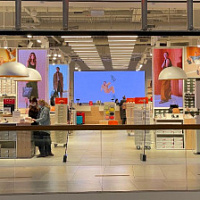
Should a shoe store spend money on digital screens?
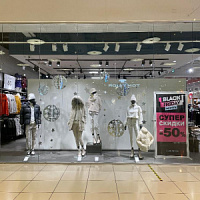
Mistakes in the lighting of the sales area that spoil the impression of a shoe store
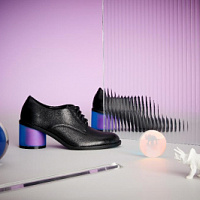
Technical aspects of display space and current trends in its design
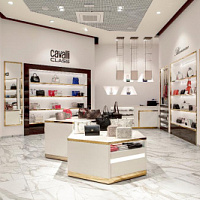
Design rules for a shoe and accessories store
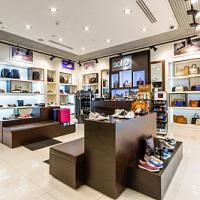
Pandemic-influenced visual merchandising transformation for shoe and accessories store
Popular
 We are ready for active development in the Russian market
Friedrich Naumann, CEO of the Tamaris brand, told Shoes Report about the company’s ambitious plans, business development in Russia and expansion of the retail network, and also shared details about new collections and launches.
We are ready for active development in the Russian market
Friedrich Naumann, CEO of the Tamaris brand, told Shoes Report about the company’s ambitious plans, business development in Russia and expansion of the retail network, and also shared details about new collections and launches.
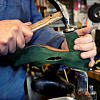 “Discount for repairs” of clothes and shoes in France supported workshops
The French have calculated the benefits of a program that encourages consumers to repair clothes and shoes by providing discounts on these services in certified workshops. The “repair discount” program began operating in France in November last year. Over the six months of operation of this program, the number of calls to repair shops in France increased 10 times and amounted to 250 repairs. The French saved 000 million euros, writes leparisien.fr.
“Discount for repairs” of clothes and shoes in France supported workshops
The French have calculated the benefits of a program that encourages consumers to repair clothes and shoes by providing discounts on these services in certified workshops. The “repair discount” program began operating in France in November last year. Over the six months of operation of this program, the number of calls to repair shops in France increased 10 times and amounted to 250 repairs. The French saved 000 million euros, writes leparisien.fr.
 Coach turned to Big Data analysis and won the interest of a young audience
American handbag brand Coach has planned the success of its Tabby model among a younger audience, Generation Z, by turning to big data analysis, abandoning traditional and analogue tools, such as human intuition or the ability of any executive to sense “which way the wind will blow,” writes B.O.F.
Coach turned to Big Data analysis and won the interest of a young audience
American handbag brand Coach has planned the success of its Tabby model among a younger audience, Generation Z, by turning to big data analysis, abandoning traditional and analogue tools, such as human intuition or the ability of any executive to sense “which way the wind will blow,” writes B.O.F.
 Why is it so important to work with customer reviews, analyze them and use them in your work?
Customer reviews are of great, invaluable importance when selling a product. However, many companies do not always understand this: they do not collect reviews, respond only to positive ones and do not work with negative ones. This is a big mistake and omission of the brand. In this article, together with SR digital marketing expert Tatyana Vasilyeva, we understand the intricacies and nuances of working with customer reviews and explain why it is worth paying attention to your customer reviews, and how this can increase your sales.
Why is it so important to work with customer reviews, analyze them and use them in your work?
Customer reviews are of great, invaluable importance when selling a product. However, many companies do not always understand this: they do not collect reviews, respond only to positive ones and do not work with negative ones. This is a big mistake and omission of the brand. In this article, together with SR digital marketing expert Tatyana Vasilyeva, we understand the intricacies and nuances of working with customer reviews and explain why it is worth paying attention to your customer reviews, and how this can increase your sales.
 Louis Vuitton opens a new factory in Italy
Louis Vuitton has opened its second shoe factory in Italy. After opening the first one in Fiesso d'Artico in Veneto, the LVMH flagship brand has just opened a new production site dedicated to this category of footwear in the industrial zone of Civitano in the Marche region. There is also another brand production facility in Tuscany, where bags and leather accessories are produced, writes fr.fashionnetwork.com.
Louis Vuitton opens a new factory in Italy
Louis Vuitton has opened its second shoe factory in Italy. After opening the first one in Fiesso d'Artico in Veneto, the LVMH flagship brand has just opened a new production site dedicated to this category of footwear in the industrial zone of Civitano in the Marche region. There is also another brand production facility in Tuscany, where bags and leather accessories are produced, writes fr.fashionnetwork.com.
 The Euro Shoes@CAF exhibition will be held in Almaty
From March 11 to 13, the Euro Shoes@CAF (Central Asia Fashion) exhibition will be held in Almaty at the Atakent exhibition complex. The exhibition, which is the largest international event in the fashion industry in Central Asia, will present collections of clothing, shoes and accessories.
The Euro Shoes@CAF exhibition will be held in Almaty
From March 11 to 13, the Euro Shoes@CAF (Central Asia Fashion) exhibition will be held in Almaty at the Atakent exhibition complex. The exhibition, which is the largest international event in the fashion industry in Central Asia, will present collections of clothing, shoes and accessories.
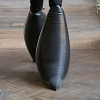 New “dutik” from Rick Owens presented at the show in Paris
Strange bulky shoes are another trend of our troubled times, and it’s impossible to ignore. American designer Rick Owens presented voluminous inflated latex boots at a show in Paris, which, according to him, were created in collaboration with the young London designer Straighteye, who likes to experiment with architectural volumes.
New “dutik” from Rick Owens presented at the show in Paris
Strange bulky shoes are another trend of our troubled times, and it’s impossible to ignore. American designer Rick Owens presented voluminous inflated latex boots at a show in Paris, which, according to him, were created in collaboration with the young London designer Straighteye, who likes to experiment with architectural volumes.
 VAGA SHOES is a new participant in the Euro Shoes premiere collection
The Russian women's shoe factory VAGA SHOES will take part for the first time in the international exhibition of footwear and accessories Euro Shoes premiere collection in Moscow.
VAGA SHOES is a new participant in the Euro Shoes premiere collection
The Russian women's shoe factory VAGA SHOES will take part for the first time in the international exhibition of footwear and accessories Euro Shoes premiere collection in Moscow.
 Euro Shoes will start operating on February 19 in Moscow!
The winter session of the international exhibition of footwear and accessories Euro Shoes premiere collection will be held in Moscow at the Expocenter from February 19 to 22. The organizers promise the presence of all the main participants at the exhibition, as well as new names from Europe, Asia and Russia.
Euro Shoes will start operating on February 19 in Moscow!
The winter session of the international exhibition of footwear and accessories Euro Shoes premiere collection will be held in Moscow at the Expocenter from February 19 to 22. The organizers promise the presence of all the main participants at the exhibition, as well as new names from Europe, Asia and Russia.
 American buyers couldn't buy Birkin bags and sued Hermès
French fashion house Hermès is facing a lawsuit in California from two customers who were unable to purchase exclusive Birkin bags. The fashion house is accused of unfair commercial practices.
American buyers couldn't buy Birkin bags and sued Hermès
French fashion house Hermès is facing a lawsuit in California from two customers who were unable to purchase exclusive Birkin bags. The fashion house is accused of unfair commercial practices.
 John Galliano and Christian Louboutin created the Tabi collection for Maison Margiela
Maison Margiela creative director John Galliano and French shoe designer Christian Louboutin released a shoe collaboration that was included in the Maison Margiela Artisanal spring 2024 couture collection. The design duo created six versions of the Tabi shoe. All shoe models in the collection have a split toe - a characteristic touch of the signature Tabi shoe model of the Maison Margiela brand. And Christian Louboutin gave the shoe its signature red sole.
John Galliano and Christian Louboutin created the Tabi collection for Maison Margiela
Maison Margiela creative director John Galliano and French shoe designer Christian Louboutin released a shoe collaboration that was included in the Maison Margiela Artisanal spring 2024 couture collection. The design duo created six versions of the Tabi shoe. All shoe models in the collection have a split toe - a characteristic touch of the signature Tabi shoe model of the Maison Margiela brand. And Christian Louboutin gave the shoe its signature red sole.
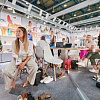 Euro Shoes starts in a month in Moscow!
There is less than a month left before the main exhibition of shoes and accessories in Russia - Euro Shoes Premiere Collection. The event will take place from February 19 to 22 in Moscow at the Expocenter, and, as always, in partnership with the largest international clothing exhibition in Russia, CPM Premiere Moscow.
Euro Shoes starts in a month in Moscow!
There is less than a month left before the main exhibition of shoes and accessories in Russia - Euro Shoes Premiere Collection. The event will take place from February 19 to 22 in Moscow at the Expocenter, and, as always, in partnership with the largest international clothing exhibition in Russia, CPM Premiere Moscow.
 Why Rendez-Vous and Yandex Lavka released a “bread bag”
Shoe retailer Rendez-Vous announced the launch of a spring collaboration with Yandex Lavka and released a roll that resembles the shape of a woman’s handbag. This “Bread Bag” is presented in the Yandex.Lavka application at a price of 249 rubles. On the product packaging there is a promotional code for 1000 rubles, which can be spent in the Rendez-Vous network.
Why Rendez-Vous and Yandex Lavka released a “bread bag”
Shoe retailer Rendez-Vous announced the launch of a spring collaboration with Yandex Lavka and released a roll that resembles the shape of a woman’s handbag. This “Bread Bag” is presented in the Yandex.Lavka application at a price of 249 rubles. On the product packaging there is a promotional code for 1000 rubles, which can be spent in the Rendez-Vous network.
 Camper has released innovative sneakers - designers
Spanish brand Camper's new Roku sneaker features six interchangeable components to create up to 64 different looks and color combinations. Roku means "six" in Japanese.
Camper has released innovative sneakers - designers
Spanish brand Camper's new Roku sneaker features six interchangeable components to create up to 64 different looks and color combinations. Roku means "six" in Japanese.
 Fashion trends Fall-Winter 2023/24 for commercial footwear purchases
Permanent contributor to Shoes Report. Elena Vinogradova, an expert in sales and purchases in the fashion business, prepared an overview of the trends for the autumn-winter 2023/24 season especially for us.
Fashion trends Fall-Winter 2023/24 for commercial footwear purchases
Permanent contributor to Shoes Report. Elena Vinogradova, an expert in sales and purchases in the fashion business, prepared an overview of the trends for the autumn-winter 2023/24 season especially for us.
 MSCHF and Crocs launch "Big Yellow Boots"
Creator of the Big Red Boots, Brooklyn brand MSCHF has teamed up with American plastic clog and sandal brand Crocs for another oversized shoe. The new Big Yellow Boots will go on sale on August 9th.
MSCHF and Crocs launch "Big Yellow Boots"
Creator of the Big Red Boots, Brooklyn brand MSCHF has teamed up with American plastic clog and sandal brand Crocs for another oversized shoe. The new Big Yellow Boots will go on sale on August 9th.
 Five rules of professional lighting for a shoe store - something that is relevant in any season
When developing a lighting concept for shoe retailers, it is important to take into account not only the history of the brand, the architectural content of the premises, the target audience of the stores, but also the seasonality of the goods. With the onset of the cold season, client preferences change: bright weightless shoes are replaced by more massive models in discreet dark colors. Despite significant differences in summer and winter collections, the overall philosophy of the brand, its recognition should remain unchanged at any time of the year. Tatyana Ryzhova, an SR lighting expert in fashion retail, has identified five basic rules for a competent lighting concept for a shoe store for readers of the magazine, which will help to present winter assortment to customers in a winning way.
Five rules of professional lighting for a shoe store - something that is relevant in any season
When developing a lighting concept for shoe retailers, it is important to take into account not only the history of the brand, the architectural content of the premises, the target audience of the stores, but also the seasonality of the goods. With the onset of the cold season, client preferences change: bright weightless shoes are replaced by more massive models in discreet dark colors. Despite significant differences in summer and winter collections, the overall philosophy of the brand, its recognition should remain unchanged at any time of the year. Tatyana Ryzhova, an SR lighting expert in fashion retail, has identified five basic rules for a competent lighting concept for a shoe store for readers of the magazine, which will help to present winter assortment to customers in a winning way.
 Bertsy: what to look for when choosing a model
Bertsy and tactical boots are becoming more and more relevant footwear, and not only because of the start of the hunting season. In Russia, there are several dozen enterprises producing this type of footwear. Oleg Tereshin, Deputy Chief Technologist of ZENDEN, told Shoes Report about the differences and features of ankle boots and what you should pay attention to when buying them in specialized retail and online.
Bertsy: what to look for when choosing a model
Bertsy and tactical boots are becoming more and more relevant footwear, and not only because of the start of the hunting season. In Russia, there are several dozen enterprises producing this type of footwear. Oleg Tereshin, Deputy Chief Technologist of ZENDEN, told Shoes Report about the differences and features of ankle boots and what you should pay attention to when buying them in specialized retail and online.
 EURO SHOES presents an updated section of the GLOBAL SHOES exhibition with collections of shoe and bag brands from Asian countries
EURO SHOES premiere collection is expanding. Along with the traditional pool of leading European footwear brands from Germany, Spain, Italy and Turkey, several dozen footwear and bag brands from the Middle Kingdom will be presented in the GLOBAL SHOES section at the Moscow Expocentre from August 29 to September 1.
EURO SHOES presents an updated section of the GLOBAL SHOES exhibition with collections of shoe and bag brands from Asian countries
EURO SHOES premiere collection is expanding. Along with the traditional pool of leading European footwear brands from Germany, Spain, Italy and Turkey, several dozen footwear and bag brands from the Middle Kingdom will be presented in the GLOBAL SHOES section at the Moscow Expocentre from August 29 to September 1.
 I doubt and object: how to find an approach to difficult clients?
How good and serene would be the work of a salesperson if the customers were calm, cheerful, always knew exactly what they wanted, and bought, bought, bought! It is a pity that this is possible only in dreams. Therefore, we will not dream, but we will act. Together with Maria Gerasimenko, a permanent author of SR, we understand the doubts and objections of buyers and build a strategy for working with them. Our expert pays special attention to the two main objections of buyers, on which 82% of sales are lost.
I doubt and object: how to find an approach to difficult clients?
How good and serene would be the work of a salesperson if the customers were calm, cheerful, always knew exactly what they wanted, and bought, bought, bought! It is a pity that this is possible only in dreams. Therefore, we will not dream, but we will act. Together with Maria Gerasimenko, a permanent author of SR, we understand the doubts and objections of buyers and build a strategy for working with them. Our expert pays special attention to the two main objections of buyers, on which 82% of sales are lost.
 Two prominent Russian fashion designers Vyacheslav Zaitsev and Valentin Yudashkin passed away
One after another, two days apart, Vyacheslav Zaitsev and Valentin Yudashkin, outstanding fashion designers, whose work for the whole world was a kind of hallmark of fashionable Russia, left this world.
Two prominent Russian fashion designers Vyacheslav Zaitsev and Valentin Yudashkin passed away
One after another, two days apart, Vyacheslav Zaitsev and Valentin Yudashkin, outstanding fashion designers, whose work for the whole world was a kind of hallmark of fashionable Russia, left this world.
 World Footwear Yearbook: Global footwear production reaches 23,9 billion pairs and is back to pre-pandemic levels
The Portuguese association of shoe manufacturers APICCAPS published the 13th edition of the international statistical bulletin World Footwear Yearbook for 2023, according to which in 2022 the production and export of shoes worldwide increased by 7,6% and 9%, respectively, and the world production of shoes reached 23,9 billion couples and returned to pre-pandemic levels.
World Footwear Yearbook: Global footwear production reaches 23,9 billion pairs and is back to pre-pandemic levels
The Portuguese association of shoe manufacturers APICCAPS published the 13th edition of the international statistical bulletin World Footwear Yearbook for 2023, according to which in 2022 the production and export of shoes worldwide increased by 7,6% and 9%, respectively, and the world production of shoes reached 23,9 billion couples and returned to pre-pandemic levels.
 Rostov footwear brand Novak presented a collection of sneakers and sneakers
In the spring-summer 2023 season, the Rostov-on-Don shoe brand Novak presented a cute collection of sneakers and sneakers for every day. The upper of the shoe is made of genuine leather, suede, nubuck, the sole is made of light EVA.
Rostov footwear brand Novak presented a collection of sneakers and sneakers
In the spring-summer 2023 season, the Rostov-on-Don shoe brand Novak presented a cute collection of sneakers and sneakers for every day. The upper of the shoe is made of genuine leather, suede, nubuck, the sole is made of light EVA.
 How to create selling visual content for online based on the identified unique selling proposition?
What is a USP (unique selling proposition) and what is it for? Why is the USP creation service in great demand among fashion retailers today? How to create a working USP? Answers questions and provides step-by-step guidance on how to define your unique selling proposition and work with it to increase online sales, Tatyana Vasilyeva, an SR expert in the promotion and development of fashion brands.
How to create selling visual content for online based on the identified unique selling proposition?
What is a USP (unique selling proposition) and what is it for? Why is the USP creation service in great demand among fashion retailers today? How to create a working USP? Answers questions and provides step-by-step guidance on how to define your unique selling proposition and work with it to increase online sales, Tatyana Vasilyeva, an SR expert in the promotion and development of fashion brands.
 Shoe educational program: what shoe soles are made of
“What is the difference between TEP and EVA? What does tunit promise me? Is PVC glue? What is the sole of these shoes made of? ”- the modern buyer wants to know everything. In order not to smash his face in front of him and be able to explain whether such a sole suits him in soles, carefully read this article. In it, process engineer Igor Okorokov tells what materials the soles of shoes are made of and what makes each of them so good.
Shoe educational program: what shoe soles are made of
“What is the difference between TEP and EVA? What does tunit promise me? Is PVC glue? What is the sole of these shoes made of? ”- the modern buyer wants to know everything. In order not to smash his face in front of him and be able to explain whether such a sole suits him in soles, carefully read this article. In it, process engineer Igor Okorokov tells what materials the soles of shoes are made of and what makes each of them so good.
 How to set prices that will earn
Some businessmen still confuse the concept of margin with the concept of trade margins and set prices for their goods, guided solely by the example of competitors. No wonder they go broke! Analyst at the Academy of Retail Technologies Maxim Gorshkov gives several tips and formulas with which you can set not only ruinous, but also profitable prices.
How to set prices that will earn
Some businessmen still confuse the concept of margin with the concept of trade margins and set prices for their goods, guided solely by the example of competitors. No wonder they go broke! Analyst at the Academy of Retail Technologies Maxim Gorshkov gives several tips and formulas with which you can set not only ruinous, but also profitable prices.
 Sales of shoes and accessories: effective techniques for business rhetoric
Which speech modules are effective in communicating with potential and current customers of shoe stores, and which are not, Anna Bocharova, a business consultant, knows.
Sales of shoes and accessories: effective techniques for business rhetoric
Which speech modules are effective in communicating with potential and current customers of shoe stores, and which are not, Anna Bocharova, a business consultant, knows.
 We form the salary of sellers: expert advice
“How do you charge your consultants for personal or general sales?” Is one of the most popular questions causing a lot of controversy and gossip on the online forums of retail business owners. Indeed, how to properly form the earnings of sellers? But what about bonuses, where to get a sales plan from, do employees allow them to buy goods at discounted stores? In search of truth, the Shoes Report turned to a dozen shoe retailers, but no company wanted to disclose its motivation system - the process of its development was too complicated and individual. Then we asked four business consultants, and finally became convinced that the topic of seller motivation is very complex, because even our experts could not come to a common opinion.
We form the salary of sellers: expert advice
“How do you charge your consultants for personal or general sales?” Is one of the most popular questions causing a lot of controversy and gossip on the online forums of retail business owners. Indeed, how to properly form the earnings of sellers? But what about bonuses, where to get a sales plan from, do employees allow them to buy goods at discounted stores? In search of truth, the Shoes Report turned to a dozen shoe retailers, but no company wanted to disclose its motivation system - the process of its development was too complicated and individual. Then we asked four business consultants, and finally became convinced that the topic of seller motivation is very complex, because even our experts could not come to a common opinion.
 The whole truth about Bayer. Who is he and how to become one?
Bayer is no longer a new, but still a popular and sought-after profession. It’s fashionable to be a buyer. Buyers are at the origins of the emergence and development of trends. If the designer offers his vision of fashion in the season, then the buyer selects the most interesting commercial ideas. It is on buyers that the policy of sales of stores and what, in the end, the buyer will wear depends on. This profession is surrounded by a magical fleur, often associated with a lack of understanding of what exactly is the work of a buyer.
The whole truth about Bayer. Who is he and how to become one?
Bayer is no longer a new, but still a popular and sought-after profession. It’s fashionable to be a buyer. Buyers are at the origins of the emergence and development of trends. If the designer offers his vision of fashion in the season, then the buyer selects the most interesting commercial ideas. It is on buyers that the policy of sales of stores and what, in the end, the buyer will wear depends on. This profession is surrounded by a magical fleur, often associated with a lack of understanding of what exactly is the work of a buyer.
 Technology Selling Issues
There is nothing worse than meeting the buyer with the words “Hello, can I help you with something?”, Because the seller works in the store just to help. Criticizing this well-established pattern of communication with the buyer, Andrei Chirkarev, business coach for effective sales and the founder of the New Economy project, shares the technology of truly selling issues with readers of Shoes Report.
Technology Selling Issues
There is nothing worse than meeting the buyer with the words “Hello, can I help you with something?”, Because the seller works in the store just to help. Criticizing this well-established pattern of communication with the buyer, Andrei Chirkarev, business coach for effective sales and the founder of the New Economy project, shares the technology of truly selling issues with readers of Shoes Report.
 Fur, and not only: types of lining
In the production of winter footwear, various materials are used that are designed to retain heat and meet the requirements of consumers: natural sheepleather, artificial fur, artificial fur from natural wool and others. All types of lining fur have their own advantages and disadvantages. Let's consider the properties of each of them.
Fur, and not only: types of lining
In the production of winter footwear, various materials are used that are designed to retain heat and meet the requirements of consumers: natural sheepleather, artificial fur, artificial fur from natural wool and others. All types of lining fur have their own advantages and disadvantages. Let's consider the properties of each of them.
 Retail Arithmetic
Before you begin to solve specific problems, you need to find out how accurately all the leaders of your company understand the basic terminology of retail.
Retail Arithmetic
Before you begin to solve specific problems, you need to find out how accurately all the leaders of your company understand the basic terminology of retail.
 How to fire a worker without tears, scandal and trial
Sooner or later, any manager is faced with the need to part with an employee. Properly and on time the dismissal procedure will save the company money, and the boss himself - nerves and time. But why sometimes, knowing that a break in relations is inevitable, we put off the decision for months?
How to fire a worker without tears, scandal and trial
Sooner or later, any manager is faced with the need to part with an employee. Properly and on time the dismissal procedure will save the company money, and the boss himself - nerves and time. But why sometimes, knowing that a break in relations is inevitable, we put off the decision for months?






